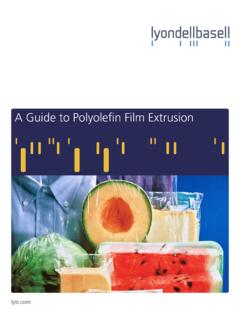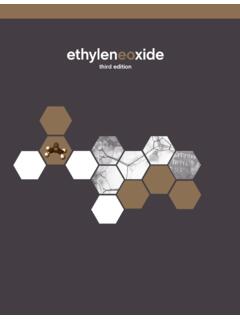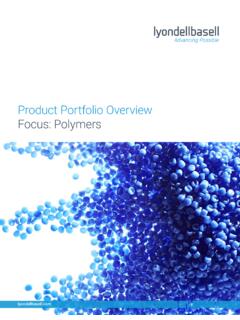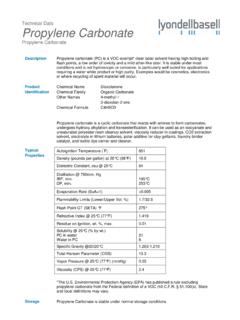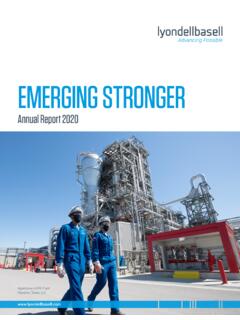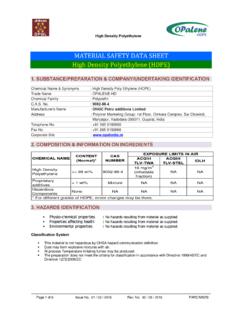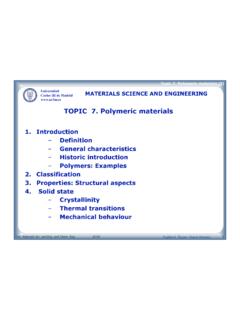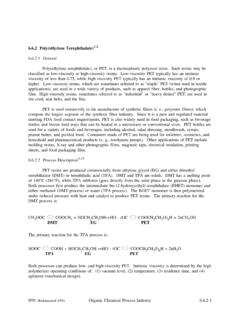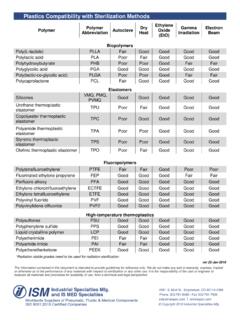Transcription of Injection Molding Guide - LyondellBasell
1 A Guide toPolyolefin Injection Molding1A Guide to Polyolefin Injection MoldingTable of ContentsIntroduction .. 2 Polyolefins are derived from petrochemicals .. 2 Molecular structure and composition affect properties and processability .. 2 Chain branching .. 3 density .. 3 Molecular weight .. 4 Molecular weight distribution .. 4 Copolymers .. 5 Modifiers and additives .. 5 Working closely with molders .. 5 How polyolefins are made .. 5 Low density polyethylene (LDPE) .. 6 High density polyethylene (HDPE) .. 6 Linear low density polyethylene (LLDPE) .. 7 Polypropylene.
2 7 Shipping and handling polyolefin resins .. 7 Material handling .. 7 How to solve material handling problems .. 9 Other material handling practices .. 10 The Injection Molding process .. 11 Injection units .. 11 Plasticator specifications .. 13 Screw designs .. 13 Nozzles .. 14 Clamp mechanisms .. 15 Clamp specifications .. 16 Injection molds .. 17 Types of mold .. 17 Sprues and runners .. 17 Mold venting .. 19 Gating .. 20 Mold cooling .. 20 Ejection devices .. 21 Spiral flow measurement .. 21 General Injection Molding operating procedures .. 22 General safety.
3 22 Heat .. 23 Electricity .. 23 Machinery motion .. 23 The Injection Molding process and its effect on part performance .. 23 The Molding cycle .. 23 Shrinkage .. 29 Warpage .. 29 Color dispersion and air entrapment .. 30 Part ejection and mold release .. 31 Clarity .. 32 Gloss .. 32 Polypropylene integral hinges .. 32 Appendices1. Injection Molding Terms .. 332. Metric Conversion Guide .. 383. Abbreviations .. 404. ASTM test methods applicable to polyolefins .. 415. Injection Molding problems, causes and solutions .. 426. ASTM and ISO sample preparation and test procedures.
4 467. Compression and Injection molded sample preparation for HDPE .. 472A Guide To Polyolefin Injection MoldingIntroductionPolyolefins are the most widelyused plastics for injectionmolding. This manual, A Guide toPolyolefin Injection Molding ,contains general informationconcerning materials, methodsand equipment for producing highquality, Injection molded,polyolefin products at optimumproduction that can beinjection molded include: Low density polyethylene (LDPE) Linear low density polyethylene (LLDPE) High density polyethylene (HDPE) ethylene copolymers, such asethylene vinyl acetate (EVA) Polypropylene and propylenecopolymers (PP) Thermoplastic olefins (TPO)In general, the advantages ofinjection molded polyolefins com-pared with other plastics are.
5 Lightweight Outstanding chemicalresistance Good toughness at lowertemperatures Excellent dielectric properties Non-hygroscopicThe basic properties of polyolefinscan be modified with a broadrange of fillers, reinforcementsand chemical , polyolefins areconsidered to be relatively easy toinjection application areas for poly-olefin Injection Molding are: Appliances Automotive products Consumer products Furniture Housewares Industrial containers Materials handling equipment Packaging Sporting goods Toys and noveltiesThis manual contains extensive information on the Injection mold-ing of polyolefins.
6 However, it makes no specific recommendations for the processing of LyondellBasell resins for specific applications. For more detailed information please contact your LyondellBasell polyolefins sales or technical service arederived frompetrochemialsPolyolefins are plastic resins polymerized from petroleum-based gases. The two principal gases are ethylene and propylene. ethylene is the principal raw material for mak-ing polyethylene (PE and ethylene copolymer resins; propylene is the main ingredient for making polypropylene (PP) and propylene copolymer resins are classified as thermoplastics, which means that they can be melted, solidified and melted again.)
7 This contrasts with thermoset resins, such as phenolics, which, once solidified, can not be polyolefin resins for Injection Molding are used in pellet form. The pellets are about 1/8 inch long and 1/8 inch in diameter and usual-ly somewhat translucent to white in color. Many polyolefin resins con-tain additives, such as thermal stabi-lizers. They also can becompounded with colorants, flameretardants, blowing agents, fillers,reinforce-ments, and otherfunctional addi-tives such asantistatic agents and structure andcomposition affectproperties andprocessabilityFour basic molecular propertiesaffect most of the resincharacteris-tics essential toinjection Molding high qualitypolyolefin parts.
8 These molecularproperties are: Chain branching Crystallinity or density Average molecular weight Molecular weight distributionThe materials and processes usedto produce the polyolefinsdetermine these basic building blocks for thegases from which polyolefins arederived are hydrogen and carbonatoms. For polyethylene , theseatoms are combined to form theethylene monomer, the polymerization process, thedouble bond connecting the carbonatoms is broken. Under the rightconditions, these bonds reformwith other ethylene molecules toform long molecular resulting product is polyethyl-ene polypropylene, the hydrogenand carbon atoms are combinedto form the propylene monomer,CH3 third carbon atom forms aside branch which causes thebackbone chain to take on a copolymers, such asethylene vinyl acetate (EVA), aremade by the polymerization ofethylene units with randomlydistributed vinyl acetate (VA)comonomer branchingPolymer chains may be fairlylinear, as in high densitypolyethylene, or highly branchedas in low density polyethylene .
9 Forevery 100- ethylene units in thepolyethylene molecular chain,there can be one to ten short orlong branches that radiate three-dimensionally (Figure 1). Thedegree and type of branching arecontrolled by the process (reactor),catalyst, and/or any branching affects many ofthe properties of polyethylenesincluding density , hardness,flexibility and transparency, toname a few. Chain branches alsobecome points in the molecularstructure where oxidation mayoccur. If excessively hightemperatures are reached duringprocessing, oxidation can occurwhich may adversely affect thepolymer s properties. This oxidationor degradation may cause cross-linking in polyethylenes and chainscission in , on the other hand,can be described as being linear(no branching) or very highlybranched.
10 Although the suspendedcarbon forms a short branch onevery repeat unit, it is alsoresponsible for the unique spiraland linear configuration of thepolypropylene are semi-crystallinepolymers which means they arecomposed of molecules which arearranged in a very orderly(crystalline) structure andmolecules which are randomlyoriented (amorphous). This mixtureof crystalline and amorphousregions (Figure 2) is essential inproviding the desired properties toinjection molded parts. A totallyamorphous polyolefin would begrease-like and have poor physicalproperties. A totally crystalline poly-olefin would be very hard resins have linear molecularchains with comparatively few sidechain branches.
